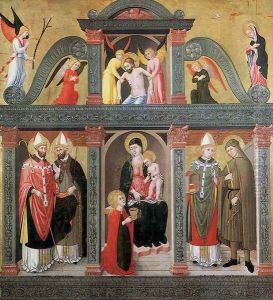Domenico Da Tolmezzo Paintings
Domenico da Tolmezzo, also known as Domenico Carnio or Domenico di Tullio, was an Italian painter of the Renaissance period, active mainly in the Friuli region in the northeastern part of Italy. Born in 1448 in Tolmezzo, a small town in the province of Udine, he was one of the notable artists from the Friuli region during the late 15th century.
Little is known about his early life and training, but his work suggests that he was influenced by the Venetian school, which was dominant in the region during that period. Domenico's style is characterized by its vivid color palette and attention to detail, typical of the Venetian tradition, as well as by certain stylistic elements that indicate an awareness of the developments in the broader Italian Renaissance.
Although Domenico da Tolmezzo's career was relatively short, he left behind a body of work that has been appreciated for its devotional quality and its role in the dissemination of Renaissance artistic values in the Friuli region. Among his most significant works are the frescoes in the Church of Santa Maria in Silvis in Sesto al Reghena and the polyptych in the parish church of San Martino in Tolmezzo. His art is noted for its narrative clarity and the serene expression of the figures he depicted.
Domenico da Tolmezzo's contributions to Italian art are a testament to the spread of the Renaissance beyond the major centers like Florence and Venice, into the smaller towns and regions of Italy. His works reflect a transitional phase in art history where local traditions began to absorb and reinterpret the new styles and techniques that were being developed in the cultural hubs of the period.
Domenico da Tolmezzo passed away in 1507. Despite being less well-known than the leading lights of the Renaissance, his work remains an important part of the artistic heritage of Friuli and provides valuable insight into the region's cultural and historical context during the Renaissance.
